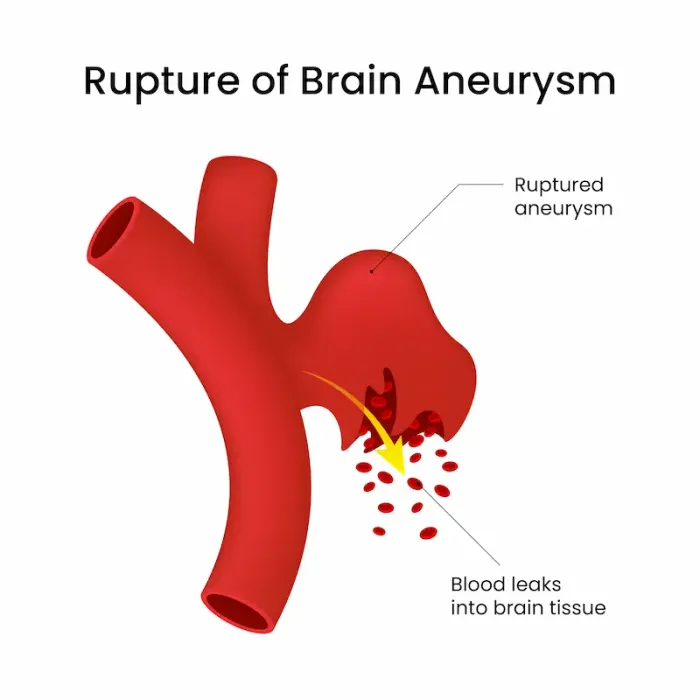Cerebral Aneurysm Rupture: Key Symptoms and Emergency Action
Learn to recognise the key symptoms of a cerebral aneurysm rupture and understand the urgent steps to take in an emergency.


Introduction
A cerebral aneurysm rupture is a life-threatening medical emergency that strikes with little warning, often described as a "brain bleed." Imagine a weak spot on a blood vessel in your brain, like a thin, overinflated balloon. When that spot bursts, it causes bleeding into the space surrounding the brain, a type of stroke known as a subarachnoid haemorrhage. The seconds and minutes following a cerebral aneurysm rupture are critical, and knowing what to do can mean the difference between life and death. This guide is designed to demystify this frightening event. We will walk you through everything you need to know, from recognising the sudden, unmistakable symptoms and executing the right emergency response, to understanding the treatment options and the challenging road to recovery. Our goal is to empower you with knowledge, because when it comes to a cerebral aneurysm, awareness is your greatest defense.
What Exactly is a Cerebral Aneurysm Rupture?
A cerebral aneurysm rupture is not a typical stroke caused by a clot. It is a haemorrhagic stroke, resulting from a burst blood vessel. To understand the rupture, you first need to understand the aneurysm itself.
The Anatomy of a Brain Aneurysm
A cerebral or brain aneurysm is a bulging, weak area in the wall of an artery that supplies blood to the brain. Over time, pressure from blood flow can cause this weak spot to stretch and grow, much like a weak spot on a bicycle tire that forms a bubble. Most aneurysms are saccular (berry-shaped) and have a distinct neck and dome. Many people live their entire lives with an unruptured aneurysm, unaware of its presence until it causes symptoms or, in the worst case, ruptures.
The Moment of Rupture: What Happens Inside Your Brain?
Rupture occurs when the thin wall of the aneurysm tears. Blood escapes under high pressure into the subarachnoid space, the area between the brain and the thin tissues that cover it. This sudden gush of blood increases pressure inside the skull, which can rapidly damage brain cells. The blood itself is also irritating to the brain tissues and can cause further inflammation and complications, such as the narrowing of other blood vessels (vasospasm), which can lead to additional brain damage. The event is often instantaneous and catastrophic, requiring immediate intervention to stop the bleeding and save brain function.
Consult a Neurosurgeon for the best advice
Recognising the Red Flags: Symptoms of a Ruptured Aneurysm
The symptoms of a cerebral aneurysm rupture are typically severe and sudden. Ignoring them can be fatal.
The "Thunderclap Headache": A Classic Sign
The most common and characteristic symptom is a sudden, excruciating headache that patients often describe as "the worst headache of my life." Unlike a migraine or tension headache that builds up, this thunderclap headache hits its peak intensity within seconds to minutes. It's a feeling unlike any other, often likened to being struck by lightning or a sudden, violent blow to the head.
Beyond the Headache: Other Critical Symptoms
A ruptured aneurysm affects more than just the head. Accompanying symptoms can include:
• Nausea and violent vomiting
• Stiff neck (caused by irritation from the blood)
• Blurred or double vision and sensitivity to light (photophobia)
• Seizure
• Drooping eyelid
• Loss of consciousness or confusion
• Cardiac arrest (in severe cases)
Warning Leaks (Sentinel Headaches): A Missed Opportunity
In about 20-50% of cases, a small leak may occur days or weeks before a major rupture. This is known as a sentinel headache. It’s a warning sign that is often mistaken for a minor headache, sinus issue, or migraine and dismissed. If you experience a sudden, severe headache that is unusual for you, even if it subsides, it is crucial to seek immediate medical attention. This could be the key to diagnosing and treating an aneurysm before a catastrophic brain bleed occurs.
Immediate Action Saves Lives: What to Do in an Emergency
Time is brain. If you suspect someone is experiencing a cerebral aneurysm rupture, your actions are critical.
Step-by-Step Emergency Response
1. Call Emergency Services Immediately: Do not wait to see if the symptoms improve. Do not attempt to drive the person to the hospital yourself. Paramedics can begin life-saving treatment on the way.
2. Stay Calm and Keep the Person Calm: Agitation can increase blood pressure and worsen the bleeding. Speak in a calm, reassuring voice.
3. Ensure They are in a Safe Position: If the person is conscious, help them lie down in a quiet, dimly lit area. If they are vomiting, gently turn their head to the side to prevent choking.
4. Do Not Give Food or Drink: The person may have a impaired gag reflex or need emergency surgery.
5. Be Ready to Inform Medics: Note the time the symptoms started and describe what happened. Mention the "thunderclap headache" specifically.
If you or someone you know exhibits these symptoms, this is a clear signal to consult a specialist immediately.
Who is at Risk? Understanding the Factors
While anyone can develop an aneurysm, certain factors increase the risk.
Uncontrollable Risk Factors
• Family History: Having two or more first-degree relatives with a history of brain aneurysms significantly increases risk.
• Genetic Conditions: Disorders like Polycystic Kidney Disease, Ehlers-Danlos Syndrome, and Marfan Syndrome weaken connective tissues, including blood vessel walls.
• Age and Sex: The risk increases after age 40 and is higher in women than in men.
• Prior Aneurysm: Having one aneurysm increases the chance of developing another.
Controllable Risk Factors and Lifestyle Changes
• High Blood Pressure (Hypertension): This is the biggest controllable risk. The constant high pressure stresses blood vessel walls.
• Smoking: It significantly increases both the risk of developing an aneurysm and the risk of it rupturing.
• Excessive Alcohol Consumption: Particularly binge drinking, which can cause sudden spikes in blood pressure.
Managing these factors through regular check-ups, medication, and lifestyle changes is a cornerstone of how to prevent aneurysm rupture.
How Doctors Diagnose a Ruptured Cerebral Aneurysm
Speed and accuracy in diagnosis are vital to prevent further brain damage.
Initial Imaging: CT Scans and Lumbar Puncture
The first test is usually a non-contrast CT (Computed Tomography) scan of the head. This can quickly detect the presence of blood in the subarachnoid space in over 90% of cases. If the CT scan is inconclusive but suspicion remains high, a doctor may perform a lumbar puncture (spinal tap). This test checks the cerebrospinal fluid for traces of blood that may not show up on the scan.
Pinpointing the Aneurysm: Cerebral Angiography
Once a bleed is confirmed, the next step is to locate the source. A cerebral angiogram is the gold standard. A catheter is threaded through an artery in the groin up to the brain vessels, and a contrast dye is injected to make the arteries visible on X-ray, clearly revealing the size, shape, and location of the ruptured aneurysm. Non-invasive tests like CT Angiography (CTA) or MR Angiography (MRA) are also highly effective and often used.
Get Your Health Assessed
Treatment Options: Repairing the Damage
The primary goal of treatment is to seal off the aneurysm from the normal bloodstream to prevent re-bleeding, which is often fatal.
Surgical Clipping: A Traditional Approach
This is an open-brain surgery performed by a neurosurgeon. The surgeon places a tiny metal clip across the neck (base) of the aneurysm, stopping the blood flow into it. The clip remains in place permanently.
Endovascular Coiling: A Less Invasive Procedure
This is a less invasive alternative. A catheter is guided from the groin to the brain aneurysm. Through the catheter, the surgeon inserts soft platinum coils into the aneurysm. The coils promote blood clotting inside the aneurysm, sealing it off. This procedure, known as endovascular coiling, is often preferred when possible due to faster recovery times.
Other Endovascular Techniques: Flow Diverters and Stents
For complex aneurysms, other devices like flow diverters (stent-like devices that redirect blood flow away from the aneurysm) or stent-assisted coiling may be used. The choice of treatment depends on the aneurysm's size, location, and shape, as well as the patient's overall health.
The Road to Recovery: What to Expect After a Rupture
Recovery is a long and variable process, often taking months to years.
Potential Complications: Vasospasm and Hydrocephalus
The initial rupture is just the beginning. In the weeks following, patients are closely monitored in the ICU for complications. Vasospasm is a dangerous narrowing of blood vessels that can occur days after the rupture, reducing blood flow and causing a secondary stroke. Hydrocephalus is a buildup of cerebrospinal fluid in the brain due to blood interfering with its normal drainage, which may require a temporary or permanent shunt to relieve pressure.
The Role of Rehabilitation Therapy
Many survivors face cognitive deficits (memory, problem-solving), physical challenges (weakness, fatigue), and emotional changes (anxiety, depression). A comprehensive rehabilitation program involving physical, occupational, and speech therapy is essential to regain lost functions and adapt to new ways of living. The long-term effects of a brain bleed can be significant, and support from family and healthcare professionals is crucial.
Can a Brain Aneurysm Rupture Be Prevented?
You cannot prevent an aneurysm from forming, but you can reduce the risk of rupture.
• Manage Blood Pressure: Regular monitoring and medication are key.
• Quit Smoking: This is the single most effective lifestyle change to reduce risk.
• Limit Alcohol and Caffeine: Avoid excessive consumption.
• Avoid Straining: Treat constipation to avoid sudden pressure spikes.
• Screening: For individuals with a strong family history (two or more first-degree relatives) or certain genetic conditions, screening with MRA or CTA may be recommended by a doctor to detect an unruptured aneurysm proactively.
Managing underlying conditions like hypertension is critical. Apollo24|7 offers a convenient home collection for tests like lipid profile and HbA1c to help you monitor your cardiovascular health proactively.
Conclusion: Knowledge is Power
A cerebral aneurysm rupture is a frightening event, but understanding its signs, risks, and the imperative of rapid action can dramatically alter the outcome. This knowledge empowers you to recognise an emergency, respond effectively, and support a loved one through diagnosis, treatment, and recovery. While the journey is difficult, advances in medical technology and rehabilitation offer hope. The most important message is to listen to your body. A sudden, catastrophic headache is not normal. Treat it with the seriousness it demands. If you have concerns about your risk factors, speak with a healthcare provider about proactive steps you can take. Your vigilance could save a life.
Consult a Neurosurgeon for the best advice
Consult a Neurosurgeon for the best advice

Dr Debnath Dwaipayan
Neurosurgeon
9 Years • MBBS, MS(Gen. Surgery), DrNB (Neurosurgery)
Delhi
Apollo Hospitals Indraprastha, Delhi

Dr. Sandeep B V
Neurosurgeon
14 Years • MBBS , MS , MCh - Brain & Spine Surgeon (Neuro Surgeon)
Bengaluru
Apollo Clinic, Sarjapur Road, Bengaluru

Dr. Balaji Srinivas S
Neurosurgeon
13 Years • M.B.BBS, MS GENERAL SURGERY, M.ch Neurosurgery
Bengaluru
Apollo Clinic, Electronic City, Bengaluru

Dr. Bharat Subramanya
Neurosurgeon
8 Years • MBBS, DrNB Neurosurg (D6Y,NBEMS), Fellowship Park Clinic Kolkata
Bengaluru
Apollo Clinic, JP nagar, Bengaluru

Dr. Aditendraditya Singh Bhati
Neurosurgeon
21 Years • MBBS(2004), DNB Neurosurgery(2014); MNAMS; Fellow Skull Base Endoscopy (Italy), Fellow Extended Skull Base ( Weill Cornell, USA), Fellow ZAP-X Radiosurgery. Member of American Association of Neurological Surgeons
Delhi
Apollo Hospitals Indraprastha, Delhi
(100+ Patients)
Consult a Neurosurgeon for the best advice

Dr Debnath Dwaipayan
Neurosurgeon
9 Years • MBBS, MS(Gen. Surgery), DrNB (Neurosurgery)
Delhi
Apollo Hospitals Indraprastha, Delhi

Dr. Sandeep B V
Neurosurgeon
14 Years • MBBS , MS , MCh - Brain & Spine Surgeon (Neuro Surgeon)
Bengaluru
Apollo Clinic, Sarjapur Road, Bengaluru

Dr. Balaji Srinivas S
Neurosurgeon
13 Years • M.B.BBS, MS GENERAL SURGERY, M.ch Neurosurgery
Bengaluru
Apollo Clinic, Electronic City, Bengaluru

Dr. Bharat Subramanya
Neurosurgeon
8 Years • MBBS, DrNB Neurosurg (D6Y,NBEMS), Fellowship Park Clinic Kolkata
Bengaluru
Apollo Clinic, JP nagar, Bengaluru

Dr. Aditendraditya Singh Bhati
Neurosurgeon
21 Years • MBBS(2004), DNB Neurosurgery(2014); MNAMS; Fellow Skull Base Endoscopy (Italy), Fellow Extended Skull Base ( Weill Cornell, USA), Fellow ZAP-X Radiosurgery. Member of American Association of Neurological Surgeons
Delhi
Apollo Hospitals Indraprastha, Delhi
(100+ Patients)
Frequently Asked Questions
1. What is the survival rate for a ruptured brain aneurysm?
Approximately 40% of ruptures are fatal within the first 24 hours. Of those who survive, about 66% will suffer some permanent neurological deficit. Early treatment is critical for improving the survival rate after aneurysm rupture.
2. Can you feel a brain aneurysm before it ruptures?
Typically, no. Most unruptured aneurysms are silent. However, if a large aneurysm presses on a nerve or brain tissue, it can cause symptoms like a dilated pupil, double vision, or pain behind the eye. A warning leak (sentinel headache) can also occur before a major rupture.
3. What causes a cerebral aneurysm to burst?
The exact trigger is often unknown, but factors that suddenly increase blood pressure can contribute. These include intense physical exertion, strong emotional upset, straining, and even sexual intercourse.
4. How long does it take to recover from a ruptured aneurysm?
The initial hospital stay can last weeks. Full recovery, if possible, can take anywhere from six months to several years. Many survivors require long-term therapy, and some deficits may be permanent.
5. Are there long-term effects after a brain bleed from an aneurysm?
Yes, long-term effects of a brain bleed can include cognitive problems (memory, concentration), physical disabilities (weakness, speech issues), chronic fatigue, and emotional changes like anxiety and depression. The extent varies greatly from person to person.

